
Vol. XVII, No. 7, November 2017
How technology is swallowing reality
When the Internet first started being adopted by consumers several decades ago, it was used as a way to find information. Then along came AOL and chat rooms with a new way to communicate and socialize, which started displacing phone voice communication. Then followed all the different versions of instant messaging, social media and video-calling apps and programs, further improving our means to communicate and socialize and displacing many of our face-to-face meet ups.
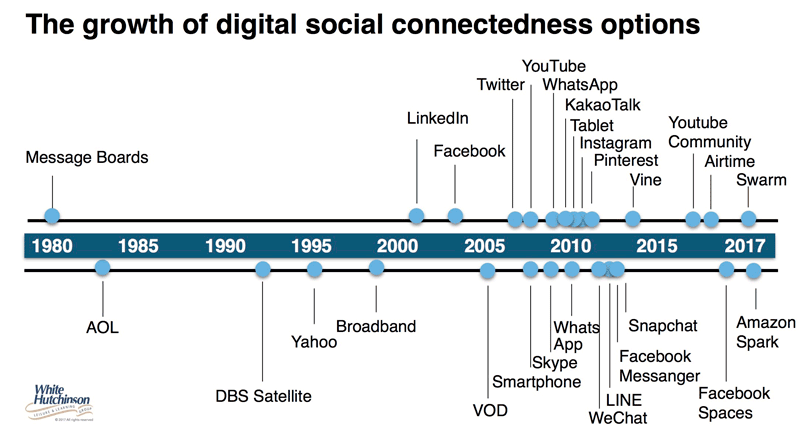
Digital disruptions have occurred with different forms of entertainment. First video games displaced the video arcade. Then Netflix displaced the video rental store. Now, Netflix, Amazon Prime, Roku and others are taking market share from movie theaters with live HD and Ultra HD movie streaming and TV show binging.
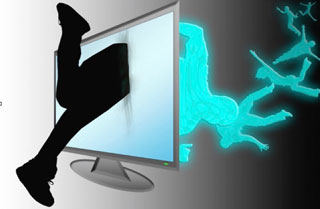
What the above describes is the migration of real world experiences to the digital world. It's not just socialization and entertainment that is being swallowed by the digital world, but also retail (ecommerce), banking and financial services (fintech), education (online learning), newspapers (online newspapers) and sports (eSports), just to name a few other consumer industries. More and more of our real world experiences now take place on the digital screen.
Now rapidly emerging on the consumer landscape are augmented (AR) and virtual (VR) reality that will make digital communication come much closer to mimicking real world face-to-face socialization and bring even higher quality, fully immersive, interactive forms of entertainment into our family rooms.
Both VR and AR, as humanity's next great disruptive change, will fundamentally transform experiences as we know them, potentially delivering a long-term impact that will most likely exceed today's most “disruptive” new technologies. As such, VR and AR will be major game changers for at-home and non-venue based out-of-home (OOH) experiences (think Pokémon Go that made the entire world an interactive entertainment stage) and a major disrupter of entertainment and face-to-face socialization experiences at OOH leisure venues.
Up until now, all the digital options that have been displacing real world experiences have been two-dimensional applications that you observe on flat-screen medium that has been around since 1896. Movie and video entertainment makes you an observer of the story; today's gaming technology makes users active participants. While you are an observer or a participant on the flat screen, you are still present and aware of where you are physically in the real world. VR takes everything a giant step further and dramatically changes the equation, as it has what is called presence - you are immersed and have the perception of being physically present in a nonphysical world - the virtual reality world it creates that you interact with appears real and feels real, just as real as the physical. You are teleported to a different location and time.
VR presence has three main elements that create its reality:
- Personal presence - you perceive that you physically exist within a virtual world.
- Social presence - you can interact with other simulated or real entities within the virtual world.
- Environmental presence - the virtual world seems aware of you and reacts accordingly.
AR, often referred to as mixed reality, takes a different approach. You stay in the real physical world and it superimposes, teleports objects and people into your real world. You then experience and interact with them as if they were real and present. AR changes the real world by injecting an imaginary one into it.
Both VR and AR will be major fundamental game changes to experiences, as they are three-dimensional and fully immersive. They offer new forms of digital experiences far more real and compelling than the digital screen now offers us. Their digital experiences will be able to literally replace what we now know as reality with a new virtual and augmented reality that will seem just as real as the physical world is now. Yes, the next Big Thing to be disrupted is reality itself, at least what we have thought of as reality up until now. VR and AR are being described as brand new forms of experiencing, the new operating system for Reality.
Out-of-home leisure venue suppliers are already embracing VR and it's getting a lot of interest at recent industry shows. These are just a few of the companies working on developing equipment, attractions, content and venues for the out-of-home VR sector as recently reported in the Stinger Report: Pimax 8K, TQ Interactive, Sangwha, Noitom, REALIS, Hashilas, LEKE VR, Brogent Technologies, Red Raion, DOF Robotics, NiceBerg Studios, Mark Rides, VR Coaster, Simworx, Frontgrid, Samsung, Dynamic Attractions, Illusion Systems, Zamperla, Holovis, Entertainment Resource, Niceberg, CL Corporation, e-Virtuality, Effeci Group, Moviemex3D, INOWIZE, Polymorph, Asterion, Ubisoft, Swift Tech Interactive, Hologate, NINED, JAMMA Amusement Technology, Movie Power, ImSim, Deephitech, Stereolife, Xtrematic, Dreampix Animation Studio, ICAROS, Bandai Namco, A.i.Solve, UNIS Technology and Eleven. VR has already been incorporated in free-roam VR arenas, such as The Void and Zero Latency; in VR arcades; VR games in gamerooms; in museums and incorporated in different theme park attractions, including updating the ride experience on older roller coasters with VR.
However, the big potential for the disruption of reality is with at-home and OOH non-venue based VR and AR reality, which is also developing at a fast pace. That's where the big bucks are being invested since the technology can be scaled to millions, even billions of people. That's enormous market and profit potential. With that growth comes a BIG disruptive threat to OOH venues, especially community leisure venues (CLVs), including traditional FECs.
Mark Zuckerberg, CEO of Facebook, recently said, "We want to get a billion people in virtual reality [in their homes]," at the company's annual Oculus VR conference for developers. Facebook's latest VR bet is its Oculus Go headset, which will start at $199 when it ships in early 2018. The headset will be standalone with its built-in computer, not requiring a smartphone, cable or wires to operate. The Oculus Go is intended to fill the "sweet spot" between expensive, higher-end VR systems like the Oculus Rift ($399) and lightweight headsets like Samsung's Gear VR ($99). Facebook also has the Santa Cruz headset in prototype-phase. This more advanced standalone headset with its own built-in computer will have position tracking, which means you can move your body around in the real world and it will affect where your virtual body moves in the virtual world, the same as what happens at The Void, DE Vr Arcade and Zero Latency VR venues. Facebook plans to spend billions of dollars over the next several years on developing VR along with paying developers to create apps and games.
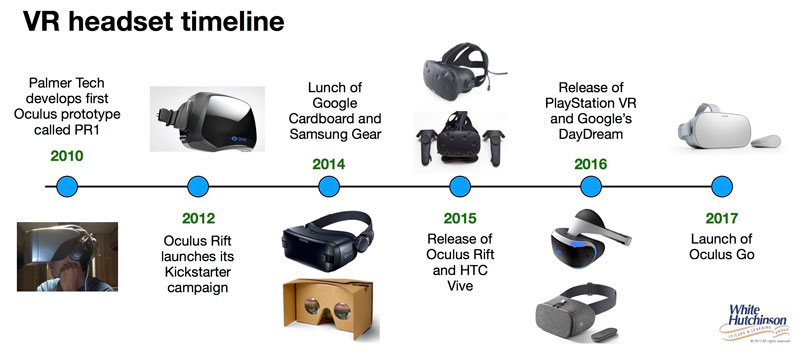
When it matures, VR will allow us to spend time with anyone in any location doing whatever we like for as long as we like. That sort of boundless pleasure sounds wonderful, but it has the capacity to devalue face-to-face interactions. Why live in the real world with real, flawed people when you can live in a perfect world that feels just as real?
“Through the illusion of presence, virtual reality allows us to directly transport people into meaningful experiences and impossible story-worlds in a way that is unlike any other medium. This is a realm that has been exclusively a property of our imaginations, and can now become an actual collective, shared conscious experience.”
Simultaneously with all the at-home VR development, consumer AR is also under rapid development. Pokémon Go was the first breakthrough application. Apple's new smartphones with 3D sensors and equipped with the latest version of iOS is designed for AR. Apple has also released ARKIt, making it easy for developers to develop AR content. However you will still need to view the world with AR through the iPhones screen.
Facebook, Microsoft, Sony, Daqri, ODG, Vuzix and many other companies are also working on AR hardware plus tons of companies on software and applications.
The BIG breakthrough with AR will probably be Magic Leap, the secretive startup company that has raised $1.8 billion to date with investments from Google, Alibaba, Qualcomm and recently the investment company Temasek Holdings. Their first product is currently in production and anticipated to be shipped in six months. It is a set of hands-free glasses that will superimpose virtually created 3-D images in your normal field of vision so you aren't required to look at the world through a video display, such as a smartphone screen. The proprietary system will project patterns of light into the eye, letting people perceive virtual objects similarly to the way they naturally see real things.
AR and VR are still in their early stages of development. We're sort of like the web in the days of dial-up when its impact was greatly underestimated by many. We're not there yet. But already, a third of Americans between the ages of 18-64 have used virtual reality, based on surveys by Madig this April. Consumer surveys by Greenlight Insights in March found that two-thirds (67%) of consumers age 18-70 are interested in social VR experiences, with 75% anticipating having VR social interactions one or more times a week. Over three-quarters (78%) of the respondents that have used virtual reality said they were interested in experiences that let them interact with someone else within a VR environment. Adoption of VR won't be limited to young male gaming aficionados. Of course, just about everyone wants good VR and AR games. But beyond that application, a national survey of 3,000 US adults by YouGov found that women and older Americans also show strong interest in the technologies' many possibilities along with a willingness to buy the latest equipment.
The existing 2,000 VR apps, including titles from the likes of Pixar, and over 100 million downloads on the Oculus platform is evidence that VR is already catching on outside of the early-adopter crowd.
Things in the VR and AR technology world are moving really fast. Some of the world's smartest people and biggest organizations with tons of money are working on it. AR and VR are fast changing from a novelty to something that becomes a part of consumers' everyday lives. What we see as reality and not WILL change significantly in the very near future.
And when it happens, its impact on entertainment and social venues could be compared to the impact television had on the movie industry. With the widespread adoption of television by the public starting right after WWII, by 1953, attendance at movie theaters fell to half of what they were in 1946.
A lot has changed since then. We now live in an age of accelerating platform development cycles and technology adoption. It took 16 years for 25% of the American population to adopt the PC after it first came out in 1975, 5 years for 25% to adopt the Web starting in 1991, but only 3 years for 25% to adopt the smartphone when it came out in 2007. So the disruption that AR and VR will bring to our lives will happen much faster than you might expect.
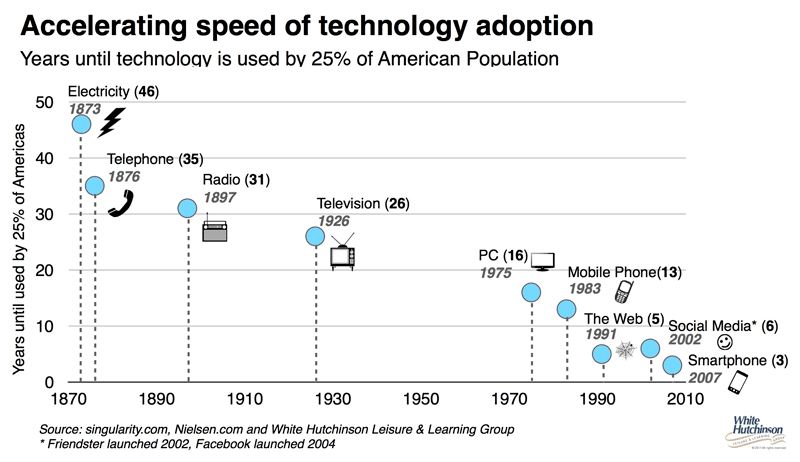
The end of the trade-off for consumers
Consumers currently make their leisure entertainment and socialization choices in terms of two key dimensions - Experience and Convenience. It's a trade-off between Fidelity, the quality of a real world experience, and Convenience - the ease of access in time, effort and money of a digital option. The more Convenient consumer digital screen-based entertainment and socialization becomes, the higher the Fidelity of an OOH real world experience has to become to compete and attract people. And as digital entertainment and socialization improves in Convenience, which it is doing at an accelerating pace, what used to be a High Fidelity experience is no longer considered High Fidelity and falls into what is called the Fidelity Belly, not a place any venue wants to find itself. The Fidelity Belly is where non-stadium seat movie theaters ended up when High Definition televisions came along.
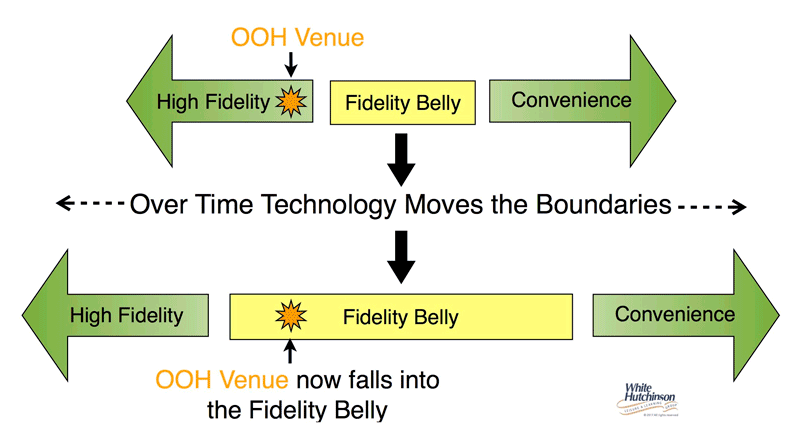
VR and AR will turn that entire trade-off equation on its head, as VR and AR offer an entirely new category of 3-dimensional immersive experiences, so they are combining the appeals of both High Fidelity and Convenience into a digital reality experience, an entirely new category of Reality. Previously, experiences were only available in the real physical world. Now, you will be able to have experiences in the digital world. Think Star Trek's Holodeck, but just not quite to that level... yet.
This will dramatically raise the bar for the Fidelity that OOH venue-based experiences will need to offer to compete with at-home and non-venue based AR and VR options. The Fidelity of the real world experience at a leisure venue will have to increase to such a high quality and become so distinctly unique to maintain its competitiveness to get people to leave their AR and VR experiences, their new reality option, and endure the inconvenience, effort, time and cost to venture out of their homes to a leisure venue. Many, perhaps most existing venue models and options are sure to fall into the Fidelity Belly.
VR and AR will enter our lives faster than we ever expected. It is poised to fundamentally transform personal at-home entertainment as we know it, potentially delivering a long-term impact that may exceed today's most “disruptive” new technologies. Strapping on a VR headset or AR glasses will catapult the user into a new realm of lifelike entertainment and social experiences that will seem believable - and very real, within seconds of putting them on.
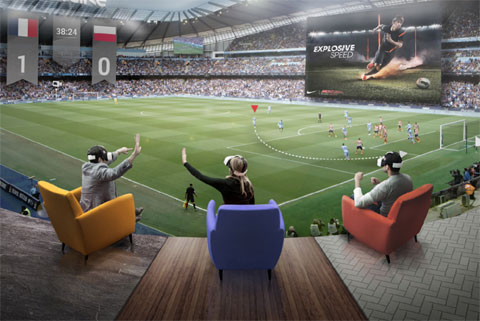
LiveLike VR enables sports fans to watch the game together with remote friends in a virtual stadium.
For example, the way that we watch sports is already changing, with several companies specializing in broadcasting live sports events in VR. With NextVR, you can watch the NBA, NFL, and other events and LiveLike VR enables broadcasters and sports teams to deliver live sports viewing experiences on mobile VR. You can now play multiplayer poker in VR with CasinoVR. It's just like being in a real casino where you can talk to other players and read their body language. You can't win real money yet but you still get the thrill of winning (or losing). There are already multiple video games you can play immersed in a 3D virtual world. You can now attend live concerts in VR. Instead of observing a movie, you can already be in it. Netflix VR is already streaming VR movies. Live Nation is making many of its concerts available for live streaming in VR. You can now immersively connect with your friends in VR on Facebook Spaces. These examples are only the beginning of all the ways VR will be transforming our leisure and social lives.
One small example of how disruptive VR and AR will be to OOH leisure venues comes from a November 2016 national survey by DabKick that found that 87% of Americans said there are benefits to watching a sporting event in VR instead of going to a sports bar. Top benefits were avoiding crowds (57%), cheaper drinks (47%) and easy access to the bathroom (39%). Americans said they were also interested in popping on a VR headset and join friends in VR to watch a movie (46%), visit a theme park (36%), attend live performances (35%) and listen to a band (33%).
Yes, not only is VR and AR technology starting to swallow reality, but you're also able to enter their new reality in your home! The quality of VR and AR equipment, its content options and its overall experience will be exponentially improving in the immediate future. The future is just around the corner.
Implications for CLVs
It's about to become a whole new ballgame to compete for consumers' leisure time and money. The bar to get a share of it is about to make a giant leap upwards, as the appeal of VR and AR entertainment and social options are about to make it even harder to get the consumer out of their home to visit a community leisure venue (CLV).
Highly accessible VR and AR home options do not mean the end of out-of-home entertainment and socialization at CLVs. However, it will feed and accelerate the long-term trend we have been documenting over the last few years in this Leisure eNewsletter of consumer digital entertainment options gaining a greater and greater share of all entertainment spending and leisure time and the migration of OOH entertainment market share to the higher socioeconomic customers visiting higher quality, higher fidelity OOH CLV experiences.
To compete with consumer at-home VR and AR options, CLVs need to raise their Fidelity. And this doesn't just mean the entertainment, such as having smart golf balls or bowling balls, more interactive games, or whatever. It requires raising the Fidelity of the entire OOH hospitality experience, everything from guest services and interaction with staff, to the design and ambiance, to the acoustics, to giving guests the gift of time, and definitely the food and drink offerings. The one thing consumers won't be able to do in the new AR and VR reality is eat and drink. That means food and beverage offerings and their experiences offer a key component to the High Fidelity route to CLV survival and success.


